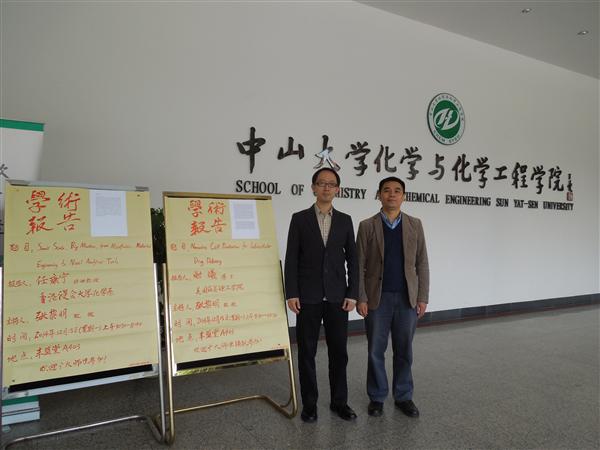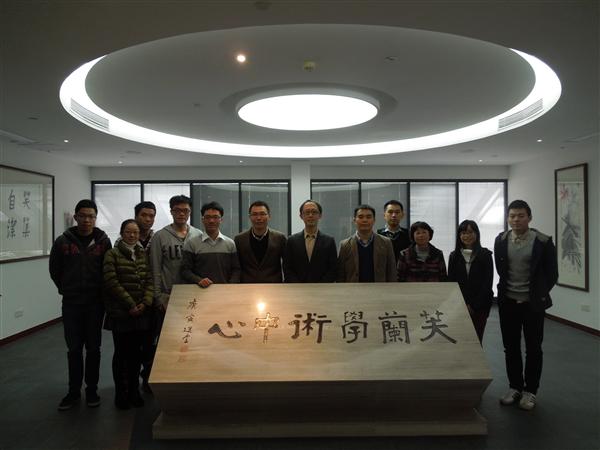報告題目:Small Scale, Big Matters: from Microfluidics, Material Engineering to Novel Analytical Tools
報告人:任康寧 助理教授
香港浸會大學化學系
主持人:張黎明教授
報告時間:2014年12月15日(星期一)上午10:30-11:40
報告地點:豐盛堂A403
Abstract:
Microfluidics, debuted in 1990s, has quickly become important enabling technology inanalyticalandbiomedical implementations. When integrated with existing technologies, it could offer not only increased processing and analyzing speed, novel functions in separation and detection, reduced cost and convenience in onsite analysis, but more importantly, the ability to effectively manipulate and study ultra-small matters such as a single cell, and to replace most biological/biomedical experiments with on-chip tests in precisely controlled environment mimickingin vivoconditions. In this talk, Dr. Kangning Ren will present his interdisciplinary research on microfluidics, and micro-total analytical systems, as well as their implementations in healthcare, food safety test and environmental monitoring.
Biography:
Dr. Kangning Ren obtained both his Bachelor''''s and Doctor''''s degree fromTsinghuaUniversity, with a major in Chemistry. Supervised by Prof. Guoan Luo, Dr. Ren''''s Ph.D work focused on micro-total analytical systems. After graduation in 2008, he came toHong Kongand worked as a postdoc for three years in Prof. Hongkai Wu''''s group at HKUST, Department of Chemistry. His research there focused on microfabrication, biomaterials, and microfluidics, and point-of-care analysis. Since 2011, he has conducted research at Stanford, mentored by Prof. Richard N. Zare in the Department of Chemistry, and co-mentored by Prof. Niaz Banaei in theMedicalSchool. During this period, he continued research on biomaterials, microfluidics, and further extended his research on point-of-care analysis, with a focus on diagnosis and food safety test. In September 2014, he joinedHong KongBaptistUniversityas assistant professor in Chemistry. His current research interests center on advanced analytical technologies, with particular emphasis on novel analytical and biomedical technologies based on functional materials and microfluidics.
Selected Publications:
1.Rajiv L. Gaur, Kangning Ren, Antje Blumenthal, Suresh Bhamidi, Sara Gibbs, Mary Jackson, Richard N. Zare, Manuel Amieva, Sabine Ehrt, Joel D. Ernst, Niaz Banaei, “LprG-mediated surface expression of lipoarabinomannan is essential for virulence of Mycobacterium tuberculosis”, PLoS Pathogens, in press (2014).
2. B. Xiong, K.N. Ren, Y.W. Shu, Y. Chen, B. Shen and H. K. Wu, “Recent Development of Microfluidics for Cell Study”, Advanced Materials, DOI: 10.1002/adma.201305348 (2014).
3. K.N. Ren, Y. Chen, H. K. Wu, “New Materials for Microfluidics for Applications in Biology, Current Opinion in Biotechnology”,25:78–85 (2014).
4. K.N. Ren, N. Banaei, R. N. Zare, “Sorting Inactivated Cells Using Cell-Imprinted Polymer Thin Films”, ACS Nano,7, 6031–6036 (2013).
5. K.N. Ren, J.H. Zhou and H. K. Wu, “Materials for Microfluidic Chip Fabrication”, Accounts of Chemical Research,46, 2396-2406 (2013).
6. K. N. Ren and R. N. Zare, “Chemical Recognition of Cell-Imprinted Polymers”, ACS Nano,6, 4314–4318 (2012).
7. J.H. Zhou, K.N. Ren, Y.H. Zhao, W. Dai, H.K. Wu, “Convenient Formation of Nanoparticle Aggregates on Microfluidic Chips for Highly Sensitive SERS Detection of Biomolecules”, Analytical and Bioanalytical Chemistry,402, 1601-1609 (2012).
8. K.N. Ren, W. Dai, J. H. Zhou, J. Su. H. K. Wu, “Whole-Teflon Microfluidic Chips”, P. N. A. S.,108, 8162-8166 (2011).
9. J.H. Zhou, K.N. Ren, W. Dai, Y.H. Zhao, D. Ryan and H.K. Wu. “Pumping-Induced Perturbation of Flow in Microfluidic Channels and Its Implications for Cell Culture on-Chip”, Lab on a Chip,11, 2288-2294 (2011).
10. K.N. Ren, Y.H. Zhao, J. Su, D. Ryan and H.K. Wu. “Convenient Method for Modifying Poly(dimethylsiloxane) to be Airtight and Resistive against Absorption of Small Molecules”, Analytical Chemistry,82, 5965-5971 (2010).
11. K.N. Ren, Q.L. Liang, X. Mu, G.A. Luo and Y.M. Wang. “Miniaturized High Throughput Detection System for Capillary Array Electrophoresis on Chip with Integrated Light Emitting Diode Array as Addressed Ring-Shaped Light Source”, Lab on a Chip,9, 733-736 (2009).
12. K.N. Ren, Q.L. Liang, B. Yao, G.A. Luo, et al. “Whole Column Fluorescence Imaging on a Microchip by Using a Programmed Organic Light Emitting Diode Array as a Spatial-Scanning Light Source and a Single Photomultiplier Tube as Detector”, Lab on a Chip,7, 1574-1580 (2007).

